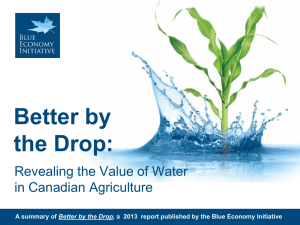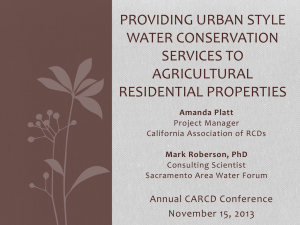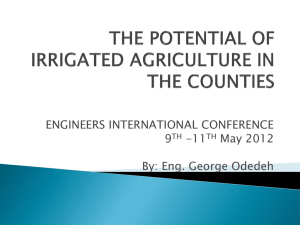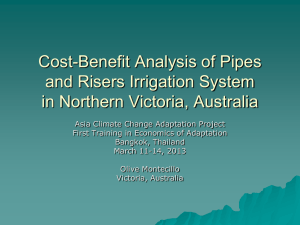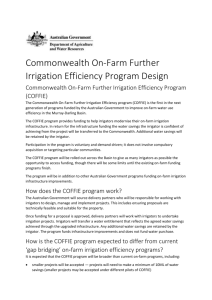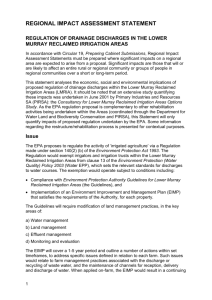WATER PowerPoint template
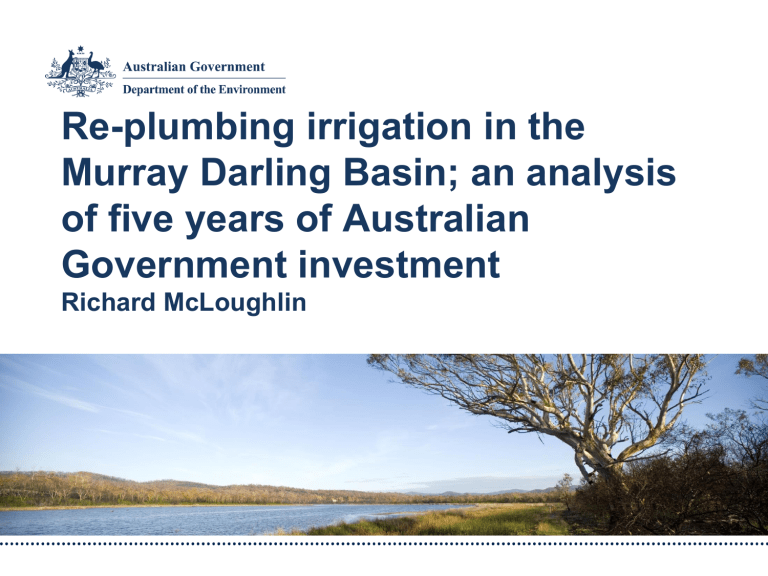
Re-plumbing irrigation in the
Murray Darling Basin; an analysis of five years of Australian
Government investment
Richard McLoughlin
Murray Darling Basin Plan
The Government has committed to implementing the Murray Darling Basin
Plan on time and in full.
This includes the commitment to bridge the gap by recovering 2750 GL
LTAAY of water for the environment.
Sustainable Rural Water Use and Infrastructure Program
The Government’s vehicle for water recovery.
Over $10 billion
Water savings are recovered for the environment in order to
‘bridge the gap’ to the sustainable diversion limits under the
Murray Darling Basin Plan through three main components:
Three components:
1. Irrigation infrastructure projects;
2. Water purchase and
3.
“Supply measures”
3,200
GL
3000
2500
2000
2,750
GL
2,100
1500
1000
500
Held environmental water*
1,900 GL contracted recoveries which count towards
'bridging the gap' to the
SDLs
Up by as much as 450 GL
('efficiency measures' with no adverse effect on social or economic outcomes)
Down by as much as 650 GL
('supply measures' that achieve environmental outcomes with less water)
Any shortfall below 650 GL will be recovered from 2016
Application of SDL
Adjustment Mechanism in 2016
Indicative residual purchasing needed to reach 2,100 GL
Indicative future infrastructure* yield
Contracted SRWUIP and SARMSP infrastructure* recoveries
Total estimated infrastructure yield
Contracted purchases and other Commonwealth recoveries
State recoveries 166 GL
0
SRWUIP Infrastructure
The majority of rural water infrastructure funds have been committed to projects in the Murray-
Darling Basin for improving the operation of offfarm delivery systems and helping irrigators improve on-farm water use efficiency.
Water savings are shared between the
Australian Government for environmental use and irrigators for consumptive use, supporting increased productivity and economic activity in regional communities.
SRWUIP Infrastructure
SRWUIP Infrastructure
State Priority
Projects (up to $3.2b)
State led projects
Victoria $1,103m
South Australia
$420m
Queensland $160m
Commonwealth led projects
NSW Private Irrigation
Infrastructure Operators
Program
Other commitments include:
On-Farm Irrigation
Efficiency $450m
Strengthening Basin
Communities
Irrigation in Tasmania
New South Wales $708m
South Australia Private
Irrigation Infrastructure
Program
Australian Capital Territory
$85m
Designing rural water infrastructure programs
• Consultation with industry has helped ground programs in local/industry experience
• Programs like NSW Private Irrigation Infrastructure Operators Program
(PIIOP) see locally-driven design for major system refurbishment
• Fit for purpose and meeting local needs
• Design built on good planning
• Sound technical underpinning
• Properly costed
• Competent project management
• Positive cost benefit
Types of Infrastructure Projects
– Planning, investigations and project design
– Works on irrigation systems off farm - modernisation and rationalisation
– Works on farm to improve water use efficiency
– Works to improve ecological health and restore natural flows
– Water saving municipal projects – e.g. storm water harvesting
Who are delivering the projects?
State government departments e.g. water, primary industry, environment
Irrigation infrastructure operators
Irrigation industry associations
Industry commodity bodies e.g. rice-growers, tomato growers
Individual irrigators
Catchment management (resource management) authorities
Local government
Water utilities
CSIRO (sustainable yields studies)
Upgrading irrigation systems off farm
Works to improve efficiency and timeliness of irrigation water delivery , e.g.
– Fixing/replacing leaky old systems
– Lining channels or replacing channels with pipes
– Automation to improve water delivery
– Metering upgrades to meet modern efficiency standards
– Reconfiguring and rationalising channel systems and farm off-takes
Examples:
• Vic Goulburn-Murray Connections Program
• NSW Private Irrigation Infrastructure Operators Program
Upgrading Irrigation Systems On farm
Works on farm to deliver and use water more efficiently and increasing productivity, e.g.
– Improving on farm storage and tail water recirculation system
– Installing pipes and risers
– Installing drip irrigation systems and centre pivot irrigation as an alternative to the traditional flood irrigation
Examples:
• On-Farm Irrigation Efficiency Program in the Southern Basin
• Victorian Farm Modernisation Program
• QLD Water Use Efficiency Program
• NSW Pilot - Farm Modernisation in Gwydir & Border Rivers
Benefits from irrigation infrastructure investment
• Community/industry support for irrigation infrastructure investment programs is generally strong
• creates jobs during roll-out
• underpins long-term viability and economic sustainability of irrigation industry and regional communities.
• Completed projects have demonstrated improved productivity benefits:
• increased crop rotation ability
• reduced labour costs
• increased crop water use efficiencies
• improved soil management
• reduced maintenance
• reduced weed control requirements
• farmer’s share of water savings available for production
Monitoring and Evaluation – NSW PIIOP example
• Regular contact with grantees to discuss progress and issues
• Milestone payments with evidence of completion of works and audited financial reports
• Financial reviews to ensure contract compliance
• Workplace Health and Safety reviews to ensure implementation of legislated requirements
• Visits by department staff to view works
• Assisting grantees to provide detailed information on the program’s key performance indicators
Analysis of SRWUIP investment in Centre Pivots
• Initial analysis of 130 centre pivot irrigators funded under SRWUIP.
• In general, costs decrease with increased area under irrigation.
State
Qld HHW
NSW PIIOP
Vic Farm
Mod
OFIEP Rd 1
OFIEP Rd 2
Total
Pivots funded
9
9
13
35
64
130
Average Area
Irrigated (Ha)
69
55
51
50
45
50
Total Area
Irrigated (Ha)
618
499
667
1,760
2,892
6,437
Capital Cost
(GST excl)
$1,574,388
$1,858,640
$2,650,155
$5,555,172
$9,791,606
$21,429,911
Cost/Ha
Irrigated
$2,546
$3,722
$3,973
$3,157
$3,386
$3,329
Cost of Centre Pivot Irrigators funded under SRWUIP
$14 000
$12 000
$10 000
$8 000
$6 000
$4 000
$2 000
$-
0
OFIEP Rd 2
Qld HHW
50
Vic Farm Mod
100 150 200
Area under irrigation (Ha)
250 300 y = 33227x -0,594
R² = 0,5203
350
Cost/Ha Irrigated
Average
Степенная (Cost/Ha Irrigated)
Liebich Estates – PIIPSA
• Wine grape and citrus in the
SA Riverland
• Included upgrades to existing infrastructure, new pumps, automation and soil monitoring
• On-farm water use reduced from 10ML/Ha to 6ML/Ha.
Trangie-Nevertire Irrigation Scheme
• Irrigation cooperative in NSW
Macquarie River catchment
• Targeted “whole of system” approach to channel distribution system and onfarm water loss.
• Returned water savings to the
Commonwealth of nearly
30GL.
• Reduced ‘boom or bust’ extremes of water supply
Lachlan Catchment Management Authority
• Regional delivery partner coordinating irrigators around
Parkes NSW
• Implemented a water storage and reuse scheme utilising lateral move irrigators
• Reduced water use by
3.7ML/Ha
• Enables consistent production level and increased financial sustainability
Where to next?
• Release of the Water Recovery Strategy
• Government priority for future recovery of water through infrastructure investment.
• Work with Basin States to develop proposed projects, such as environmental works and measures, that can deliver Basin Plan environmental outcomes with less water, thus leaving more water available for consumptive use.


